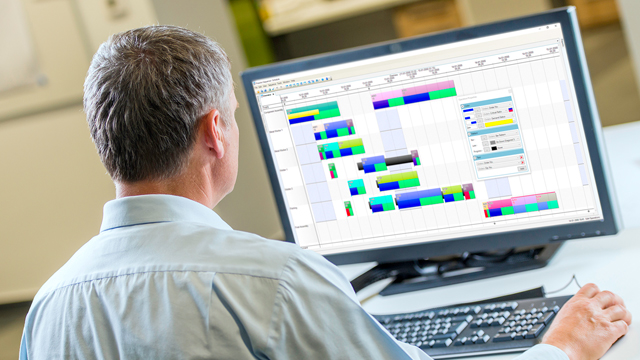
Manufacturers can improve their operations by implementing a variety of strategies and tools, especially in the production area. Scheduling is one such strategy, as is the software that can aid in its implementation.
In this blog, we’ll define job scheduling software for manufacturing, explain why it’s essential for manufacturers, and explain how manufacturing scheduling varies from production planning. We also discuss how to create a schedule and a few challenges you may encounter.
What Exactly Is Job Scheduling Software for Manufacturing?
Manufacturers use a manufacturing schedule to establish a timeline for their manufacturing processes. It is primarily a calendar that will specify when each stage of the product inception cycle occurs. This schedule generates more accountability, allowing essential tasks to be finished rather than simply hoping the responsibility will be met at some point. It also includes a deadline to ensure that activities are finished on time.
It also enables resource management. When you understand the precise timings of some stages, you can have the appropriate tools, industrial equipment, materials, and staff in the right spot at the right time. A digital system that improves this process is manufacturing scheduling software. A production schedule contains many variables, which can make it a complicated task without technical assistance.
What Is CAD ERP Integration in Manufacturing?
One integration that manufacturing companies are increasingly requesting is CAD ERP integration. This connects a company’s engineering and production, which helps to simplify these processes. CAD is an abbreviation for computer-aided design, and it pertains to software that technicians use during the design stages of a product before it is built.
What Is the Distinction Between Production Scheduling and Production Planning?
Production planning and scheduling are frequently used interchangeably, and while there is undeniable overlap, it is critical to understand the subtle differences. Production planning is broader and more concerned with the ‘what.’ The plan will cover the entire manufacturing process, ensuring that the producer is ready from start to finish.
A production schedule is a relatively small component of a larger production plan that only concerns itself with the ‘when.’ Production planning enables manufacturers to establish a clear framework in order to achieve the desired results.
What Are the Most Significant Production Scheduling Challenges?
Certain contributing factors to a company’s production schedule can have a negative impact if poorly managed. It’s worth noting that good production scheduling software can help to reduce these risks. Here are some examples of common scheduling issues:
Overcommitting
It is tempting for any company to be overly optimistic about its capacity, as they wish to generate the most income possible. However, carrying on too much and stuffing the calendar to the brim can lead to lower revenue. Workers will most likely become overstressed, resulting in dissatisfaction and poor productivity. Overuse of equipment also increases the likelihood of damage, and clients will become dissatisfied if you are unable to meet the demand you have committed to.
Untrustworthy Suppliers
If you get your raw materials from an untrustworthy supplier, it can easily delay your production schedule. If some materials are delivered a day or two late, manufacturing may be halted. You must check the credentials of any potential new partner. If effectiveness is consistently poor, it may be time to end an existing partnership.
Lack of Collaboration
If your company’s separate components are not integrated, it can lead to a lot of inconsistency and ambiguity in its production schedule. All parties involved in the process should engage on a regular basis, and information should flow freely. Otherwise, the operation may fail because employees will lack a unified understanding of what is going on.
Variations
If a deviation from the destined path occurs during the manufacturing cycle, there is a threat that it will have a negative impact on the entire supply chain. For instance, a piece of equipment could fail, preventing the anticipated schedule from taking place. In this case, it is critical to use a system that is adaptable and can quickly account for changes.
How Do You Generate a Manufacturing Production Schedule?
A great place to begin when generating a production schedule is by glancing at some of the various types of schedules that occur and selecting the one that is most suitable for your operation. Some well-known scheduling methods are as follows:
- Infinite capacity scheduling
- Finite capacity scheduling
- Backward incremental scheduling
- Forward incremental scheduling
- Make to stock scheduling
- Make-to-order scheduling
How Does Manufacturing Scheduling Software Help?
The right software solution must be able to cope with complexity in a straightforward manner, taking into account all production-related data and allowing the best possible schedule based on accessible resources.
Here are a few more advantages provided by manufacturing scheduling software:
- increased revenue
- quicker turnaround
- increased visibility
- improved customer satisfaction
- Fewer errors
- Appropriate material quantities
Take Away
Job scheduling software for manufacturing provides manufacturers control over their operations by clearly displaying the status of each order. Workers will know exactly what must be accomplished next, and customers will be provided with a precise timeframe.
Not only that, but manufacturing software is a complete business management solution, which means that your production planning activity is linked to your sales, inventory, and accounting data, making automation a real option. All departments have a better sight of the big portrait and any plans that are in place.



